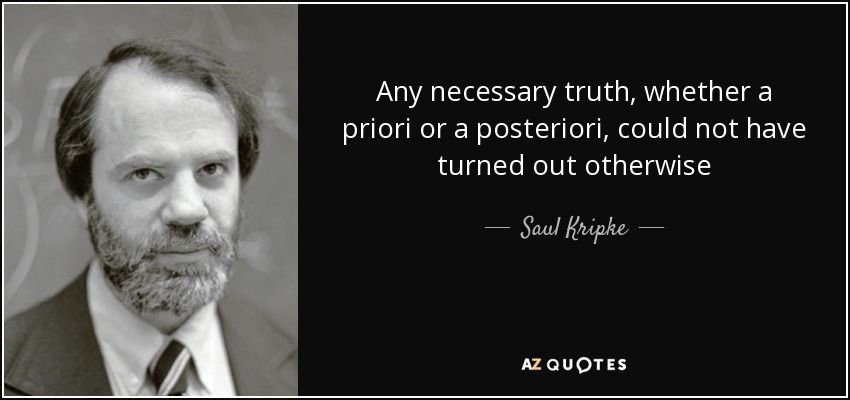Evaluating Saul Kripke's Critique of Cluster Theory🔊
 Gary Meade
Gary Meade
This essay article is a proofread & edited version of my Philosophy 3A first semester module exam essay.
The original final draft can be found here 👉Philosophy 3A
The origins of the trusted theory of naming lie in the description theories offered by Frege and Russell. They argue that proper names have referents and that these referents describe the proper names in a specific manner, known as its sense. Russell believed that the meaning of the proper name is equal to the meaning of the definite description that the speaker associates with the proper name, and that these definite descriptions could be seen as phrases that qualify the proper name to refer to its referent. Frege agreed that definite descriptions provide a sense for proper names. Both men thought that the definite descriptions refer to the referent by its meaning being a condition that, if satisfied, is the meaning of the referent. From this, both men came to the conclusion that there is no difference between proper names and definite descriptions (Mill, 2008).
This version of the Description theory was evolved to the Cluster description theory of naming by scholars and philosophers to bolster its main assumptions from attacks that could harm the single description theory. The cluster theory, as Kripke sees it in Naming & Necessity, can be looked at in two ways. Firstly, the description theories of naming give meaning to the proper names. Secondly, the definite descriptions determine the referent when the proper name is used. At the end of Kripke’s first lecture, he concludes that supporters of the cluster or description theories are implicated in committing to 6 theses that he specifies. He adds a condition that these theses must abide by, which is the condition of non-circularity when describing a proper name. This essay will analyze Kripke’s arguments against these 6 implications of the cluster theory to find out why they have been considered false by Kripke. The essay will examine the argument against each of theses, beginning with the second one and ending with the sixth, while excluding the first one as Kripke explains that it is a definition necessary for the cluster theory and, therefore, cannot be argued against.
The second thesis states that the properties that are believed to belong to the object pick it out uniquely. Kripke's point of objection is that generally, people do not have a large enough conceptual or semantic knowledge to avoid using another proper name or description to assist in describing an object uniquely. Therefore, by using another proper name to assist the speaker creates a situation where one is now describing two proper names instead of uniquely describing one of them. (Kripke,.1972:203) Kripke believes that this thesis is false because people will regularly commit this error of circularity, and because one can create a situation where it is easy to use a referent in a description that picks out another referent. (Kripke,.1972: 203)
The third thesis states that if enough of the right weighted properties are satisfied by a unique object (A), then (A) is the referent for the speaker. Kripke's (1972:203) rebuttal to this thesis begins by arguing that if Thesis 2 is false, then the rest should be as well. This is because if there are many counterfactual situations where (A) does not have any of the properties necessary to be a referent to the name or is not unique in satisfying those properties, this goes against the goal of theories of naming, which is to explain how we as speakers use language to pick out objects in the world uniquely. Kripke claims that it would be false to say that the object (A) that refers to the proper name is a necessary truth. He provides examples such as the Godel-Schmidt case and the example of an examiner associating the description "the writer of this essay" with the proper name "Gary," but later discovering that "Ben" actually wrote the essay. These examples show that another object "Ben" may be discovered to better satisfy the properties that "Gary" refers to. Based on this reasoning, Kripke concludes that this thesis is false as well.
The fourth thesis states that if no unique objects satisfy the properties, then the name does not refer to anything. Kripke (1972:204-205) believes this thesis to be false, as he argues that there are examples where proper names still refer to objects but do not uniquely satisfy any of the properties apparently needed to refer. For example, if someone calls their car "Speedy" because they think it is the fastest car in the world, but this fact is incorrect, the name "Speedy" still refers to their car regardless. Situations where the descriptions or properties associated with a referent turn out to be incorrect also provide opposition to this thesis, as those associated descriptions may in turn be referring to no one at all, but the name can still refer to the referent.(Kripke,.1972:204-205)
The fifth thesis of Kripke's Cluster theory states that if "X" exists, then "X" satisfies most of the properties if the object (A) it is referring to is known a priori. According to Cluster theory, definite descriptions are equal to proper names and can replace each other without changing the value of the truth of the statement. Therefore, it should be true to say that if "n" is a proper name and "F" is the definite description referring to "n," and "F" exists, then "F" = "F," and "n" = "F" is a priori knowledge. However, Kripke (1972:204-205) asserts that this is not the case. This must be a posteriori knowledge to be able to attach those descriptions to the object. Therefore, this thesis can be seen as false.
The final thesis states that if "X" exists, then it is a necessary truth that those properties are true of "X." Kripke (1972:204-205) argues that this implies that in any world, those properties should still be true of "X," and the cluster of properties is identified as equal to the name and therefore must be necessarily attached to "X" in all possible worlds. However, Kripke identifies two issues with this thesis. Firstly, those associated properties or descriptions of the object are not necessarily true, but rather contingent, if true at all. Secondly, there is a confusion between the importance of the property or description with the necessity of it. The most important property in determining the reference may be a contingent fact, and this conflation of important facts with properties illustrates why properties that are thought to be important in determining the referent in Cluster theory do not amount to necessary truths about the object.(Kripke,.1972:204-205)
Based on the arguments presented above, I believe that Saul Kripke's critique of Cluster theory's six theses is valid in its implications and analysis. However, it can also be said that the arguments for Cluster theory do have strengths that Kripke admits to, but does not convincingly lessen their significance, in my opinion. Firstly, in Cluster theory, names are associated with descriptions and name references are fixed by these descriptions. Therefore, merely stating that a proper name is the name for an object is enough to fix the referent to the name. Kripke believes this is an important strength of Cluster theory, as it solves a crucial question of naming theories of how proper names link to objects (Mill, 2008). Cluster theory solves issues of identity statements that have two proper names by stating that we as speakers associate different descriptions with two names and then it is discovered that these two differing descriptions refer to the same objects, as each proper name has its own associated properties that qualify it (Mill, 2008). Thirdly, when inspecting questions of existence of proper names like "Does Plato exist?", it may seem like one may not refer to an individual or their existence by including the proper name in question, but Cluster theory sees this as a question of whether someone exists that has the properties that refer to Plato (Mill, 2008). These three objections or strengths of Cluster theory may have been underestimated by Kripke.
However, it may be said that the arguments against the six main theses that underpin Cluster theory, and the fact that Cluster theory relies on descriptions to give reference to proper names, because there seems to be no clear way to determine which of the many varying descriptions of the same object provides the meaning to the proper name, were strong enough to persuade me to agree with Kripke's evaluation of Cluster theory.
In conclusion, this essay has discussed Saul Kripke's critique of Cluster theory and its six main theses. Kripke argues that these theses are false and that proper names do not necessarily have a unique set of associated properties or descriptions. While Cluster theory does have some strengths, such as the ability to solve issues of identity statements and the ability to answer questions of existence, Kripke's critique is convincing enough to raise concerns about the validity of the theory. Therefore, it is important to consider both the strengths and weaknesses of Cluster theory when discussing theories of naming and reference.
References
MILL, A.R.T., NOTION, A.C.I.F.S. and SENSE, O., 2008. Kripke:“Naming and Necessity”.
Kripke, S.A., 1972. Naming and necessity. In Semantics of natural language (pp. 253-355). Springer, Dordrecht.
Subscribe to my newsletter
Read articles from Gary Meade directly inside your inbox. Subscribe to the newsletter, and don't miss out.
Written by
